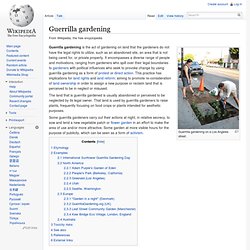

Seed Balls Take The Hard Work Out Of Planting. Gardening is a pleasure for many people, but others find it something of a chore.

If you fall into the latter camp, try creating seed balls for easy growing with minimal ground preparation. By coating seeds in clay, soil and fertiliser, seeds can easily establish in areas that are considered difficult or impossible to prepare. The ancient technique is attributed by the Permaculture Research Institute to Japanese farmer Masanobu Fukuoka. Over on Heavy Petal, Andrea Bellamy shows how to create these simple balls that can be packed with your favourite seeds — all that’s needed is some red clay and some compost mixed with the seeds you want to grow and some water. Seed balls are great for reclaiming derelict areas with thin or poor soil, making them ideal tools for guerrilla gardening. Rolled into balls and dried out, the seed-packed spheres can be easily scattered wherever needed.
Rebel Rebuild Rewild. Community gardens map. Community gardens map. Community Garden. To find a community garden near you, check out the Sprig website, launched in Spring 2014, which has an overview of Ottawa community garden features here and a list of contacts here.

Click image for the Sprig Ottawa guide to community gardens. Click here for the Just Foods introduction to community gardens in Ottawa. Click on the image below to see the Just Foods Buy Local Food Map; then select ‘Community Gardens’ for locations and details. Click image for the Just Foods community garden map. See also the Slow Ottawa Garden and Compost pages. Like this: Like Loading... Seed Balls Take The Hard Work Out Of Planting. The Leveller. The Pansy Project - Home. Ottawa Guerilla Gardeners. Nourishing Communities. Find other case studies that share these features:Access to healthy food | Creating viable farm income |Promotion of local food and regional development | Multi-stakeholder |Collaborative food systems development | Eastern Ontario Case study written by Sarah M.L.

Walker and Patricia Ballamingie Personal Interview with Moe Garahan, Executive Director, September 6, 2011 (Sarah M.L. Home. Meal Exchange. The Students for Good Food for All project is a partnership between Meal Exchange and Community Food Centres Canada that will cultivate mutually beneficial connections between campuses and Community Food Centres.

Community Food Centres Canada works with partner organizations across Canada to create Community Food Centres that bring people together to grow, cook, share and advocate for good food for all.Through an innovative mix of programs offered under one roof, Community Food Centres meet immediate food needs, promote physical and mental health, reduce social isolation, and foster more connected and resilient communities. Since 1993, Meal Exchange has supported students to raise food and funds for food banks. The Students for Good Food for All project provides student-leaders with the tools, knowledge and support they need to: To find out more about the project and to apply to lead this work on your campus, go to our online application form.
Permaculture Project Ottawa — OPIRG-Carleton. Liberation permaculture is a design approach for building sustainable and socially just living environments.

It uses biological principles to situate human habitation harmoniously within local ecological systems and the greater biosphere as a whole. Permaculture is grounded in three guiding principles: Earthcare, Peoplecare, and Fairshare. These principles inform decisions on how living spaces, material systems of exchange and society could be re-organized in pursuit of building sustainable and socially just communities. Liberation permaculture in particular focuses on confronting numerous intersections of systems of oppression such as: capitalism, colonialism, patriarchy, racism, ablism, etc. It situates itself within and in solidarity to the greater movement for social and ecological justice. In the past we have given workshops on guerrilla gardening, “seed bombs” and liberation permaculture in conjunction with various other groups. Contact: permaculture.project.ottawa@gmail.com. Guerrilla gardening. Guerrilla gardening on a Los Angeles street.

Guerrilla gardening is the act of gardening on land that the gardeners do not have the legal rights to utilize, such as an abandoned site, an area that is not being cared for, or private property. It encompasses a diverse range of people and motivations, ranging from gardeners who spill over their legal boundaries to gardeners with political influences who seek to provoke change by using guerrilla gardening as a form of protest or direct action. This practice has implications for land rights and land reform; aiming to promote re-consideration of land ownership in order to assign a new purpose or reclaim land that is perceived to be in neglect or misused. The land that is guerrilla gardened is usually abandoned or perceived to be neglected by its legal owner.
That land is used by guerrilla gardeners to raise plants, frequently focusing on food crops or plants intended for aesthetic purposes. Etymology[edit] Examples[edit] North America[edit]